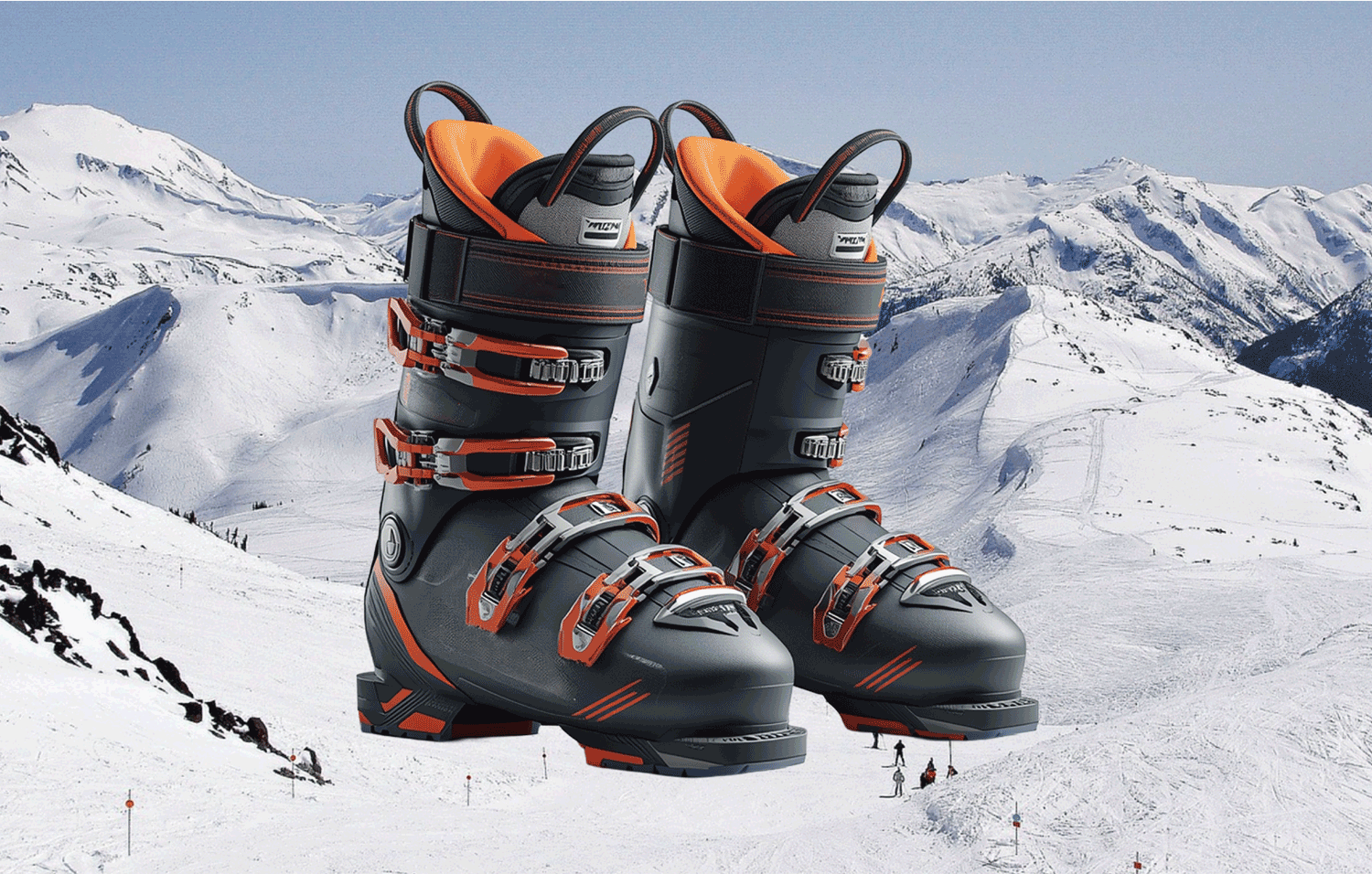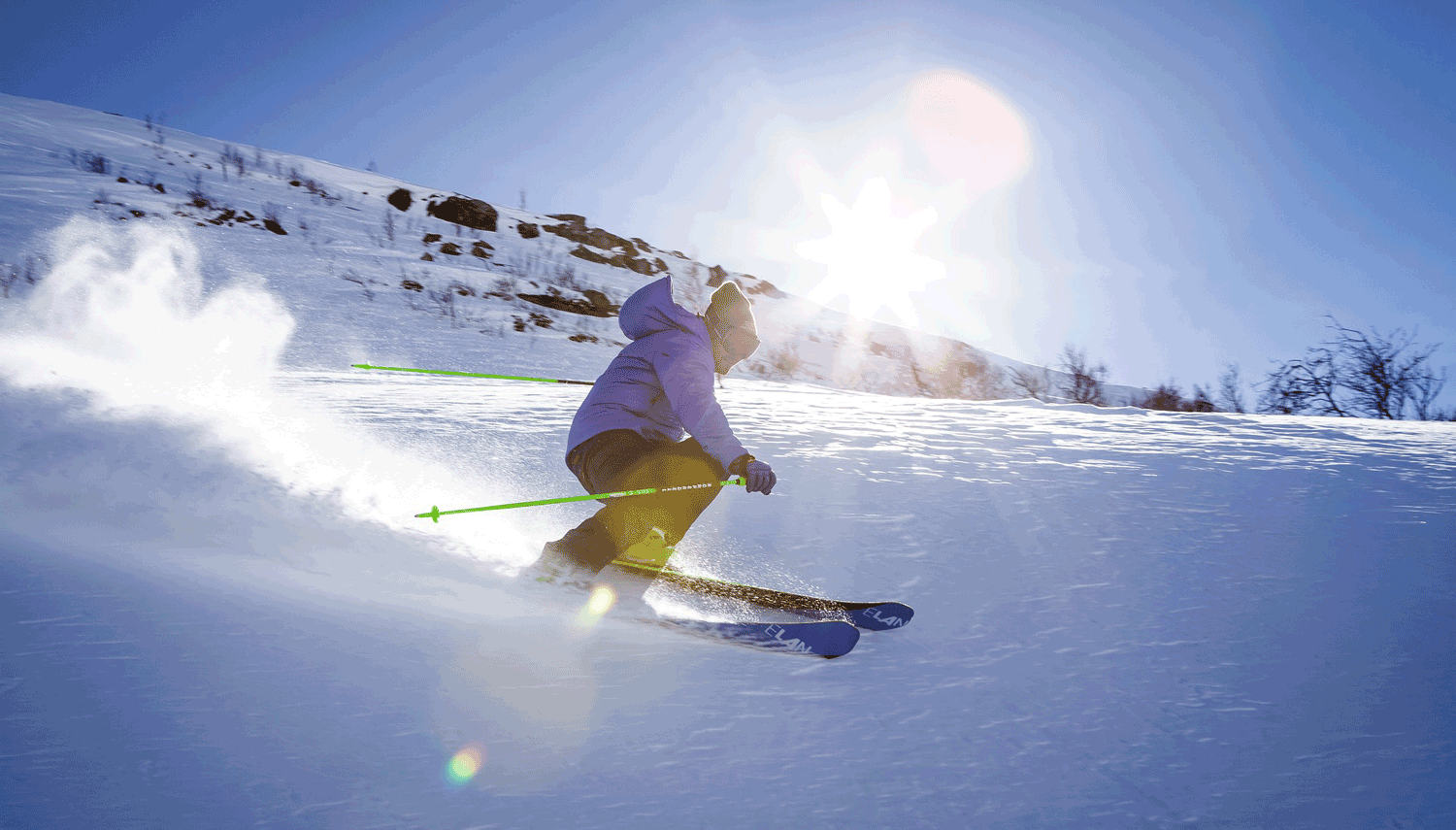Key Factors When Buying Ski Boots as an Intermediate Skier
There are several factors to consider when buying ski boots as an intermediate skier. Getting them right will not only help you avoid discomfort, but it can also help improve your skiing ability.
Choosing and sizing the right ski boots is one of the most important factors in improving how well you ski. A properly fitted boot ensures that your energy is efficiently transferred into the ski, giving you smoother, more responsive turns and greater control over your speed and direction.
When your boots fit well, your skis react more precisely to what your intended movements are, helping avoid delayed or unstable movements.
The right fit also helps maintain proper body alignment and balance. Boots that match your anatomy and flex level support your shins and ankles in a natural forward stance, which keeps you centered over your skis. Ill-fitting boots, on the other hand, can force you into awkward positions that can, even just slightly, make it harder to stay balanced, turn accurately, or stop effectively.
By keeping your feet secure and aligned, good boots allow you to ski with less effort and help you execute better technique.
Comfort plays a big role too. Properly fitted boots can help you avoid painful pressure points, cold toes, and shin bang. Comfortable boots let you stay relaxed and focused, improving both endurance and performance. The more comfortable and responsive your boots are, the more confidently you’ll ski, especially as you start tackling more challenging terrain.
Ski Boot Fit & Sizing
A boot that is too loose will allow your foot to move independently of the shell, making it difficult to control your skis, particularly when carving or navigating snow conditions that are inconsistent and unpredictable. Conversely, a boot that has just the right snug fit will help provide a more direct connection between your foot and the ski, allowing for more precise power transfer and better control. The snug fit should feel secure without causing pain or creating pressure points.
Heel and Toe Positioning
Your heel should stay firmly in the heel pocket, and your toes should lightly touch the front of the liner when standing upright. This helps prevent heel lift, which can significantly reduce control and stability.
When you flex forward, your toes should pull slightly back from the front of the liner. This small but critical adjustment allows you to maintain balance and leverage when skiing. And it will help keep your weight centered over the skis which will help improve responsiveness on turns.
Understanding Ski Boot Sizing
Using the correct sizing system is essential. Ski boots are measured using the Mondopoint system. This technique measures the length of your foot in centimeters, rather than the conventional shoe sizes. Traditional shoe sizes are inconsistent across brands and regions, making them unreliable when attempting to select the right boot. Mondopoint provides a standardized measurement that helps ensure your foot fits the shell correctly.
Finding the Right Boot Width
The width or “last” of the boot is equally important, as it affects how snugly the boot fits around the forefoot and midfoot. Most intermediate skiers will find a medium width to be a good starting point. Medium is roughly 100–102 millimeters at the forefoot. Skiers with narrower or wider feet may need boots designed specifically to accommodate their foot shape.
Balancing Liner and Shell Fit
A proper liner and shell fit is crucial for comfort and performance. The liner should closely match the contours of your foot and, ideally, be heat-moldable, so it can adapt over time to your specific foot shape.
The shell should provide support without pinching or constraining movement. When both components fit well, the boot becomes an extension of your foot. Improper liner or shell fit can create pressure points and reduce control.
Choose the Right Socks
It is important to try boots on with the ski socks you plan to wear. Thick or extra-padded socks may work in casual winter footwear, but they can alter the fit of a ski boot and create pressure points and/or reduce heel hold. Thin, technical ski socks provide warmth and moisture-wicking without adding bulk. This will help ensure the snug fit of the boot is maintained.
Test Fit at the Right Time
Finally, a helpful bonus tip is to try boots on at the end of the day, when your feet are slightly more expanded from daily activity. This provides a more realistic sense of fit, helping prevent boots that feel fine in the morning but become uncomfortable after hours on the slopes. Taking this extra step increases the likelihood that your boots will remain comfortable and perform well throughout the day, reducing fatigue and enhancing control.
Ski Boot Flex & Stiffness
The flex rating of a ski boot, which measures its stiffness, is one of the most important indicators of performance. A higher number means a stiffer boot. Stiffness will offer more precision and power, but it also demands more skill and strength to control. Choosing the right flex is essential for achieving both comfort and performance on the slopes.
Ideal Flex for Intermediate Skiers
For intermediate skiers, a medium flex is generally ideal. For men, this typically ranges from 85 to 100, though some sources suggest 80 to 110. For women, a flex of roughly 65 to 90 is recommended, depending on factors such as size, strength, and skiing style. Selecting the appropriate flex ensures that the boot supports your skill level without being overly restrictive or too soft.
Factors That Influence Flex Selection
Several factors beyond gender and size influence which flex is best. Your weight, skiing style, preferred terrain, and how aggressively you ski all play a role. A boot that is too stiff can make it difficult for lighter skiers to maintain balance and control, while a boot that is too soft may feel unresponsive at higher speeds. Choosing the right flex allows you to ski efficiently and comfortably without straining your body.
Terrain, Style & Progression Goals
Matching Your Boots to Your Terrain and Style
Think about where and how you ski when choosing boots. As an intermediate skier, you may spend most of your time on groomed slopes, but maybe you are starting to try skiing on uneven snow or areas just off the groomed trails. The right boot should align with both your preferred terrain and your skiing style, providing the right balance of control and comfort.
Choosing Boots That Support Your Progression
If your goal is to progress by carving faster or tackling steeper terrain, consider a boot with slightly higher flex and more support while still maintaining comfort. This added stiffness can enhance performance as your skills improve. However, going too aggressive too soon can work against you by making the boot difficult to control and tiring to wear.
Features & Adjustability
Buckles and Power Straps
When evaluating ski boots, pay attention to the quality, adjustability, and ease of use of the buckles and power straps. These components play a key role in how securely the boot holds your foot and how easily you can make adjustments on the mountain. Look for designs that are simple to operate even when your hands are cold or when you are wearing gloves. Convenience can make a big difference during a long day on the slopes.
Shell and Liner Customization
Many modern ski boots offer options for customization, including heat-moldable liners and shells that can be adjusted to achieve a better fit. Customization not only improves comfort but also enhances control and responsiveness. Working with a skilled boot fitter can help fine-tune these adjustments to your individual foot shape, ensuring the best possible fit and skiing performance.
Walk Mode for Added Versatility
If you plan to do any hiking, boot-packing, or exploring terrain beyond groomed trails, having a walk mode can be a valuable feature. Walk mode allows for greater range of motion when walking or climbing, making it easier to move comfortably off the skis. However, if you primarily ski within resort boundaries, this feature may be less critical.
Weight and Sole Design
The weight and sole design of a ski boot influence both comfort and performance. A lighter boot makes walking and touring more comfortable, but lighter materials may offer less support under heavy load or at high speeds. Finding the right balance between weight and support ensures that your boots perform well without sacrificing comfort or stability.
Budget vs Investment Ski Boots
The Risks Associated with Choosing Cheap Ski Boots
Buying boots that are too inexpensive, do not fit properly, or have the wrong flex can lead to regret. Pain, discomfort, and poor skiing performance are common consequences of poorly chosen boots. Investing time in finding the right fit and flex is crucial to avoid these issues and ensure a more enjoyable skiing experience.
Investing in Your Progress
If you ski regularly and hope to improve, it may be worthwhile to spend a bit more on boots and work with a skilled boot fitter. A properly fitted boot tailored to your foot and skiing style can make a significant difference in performance and comfort, far outweighing the appeal of simply buying the cheapest option that looks acceptable.
Choosing Ski Boots Carefully Can Make All the Difference
Ski boots are arguably the most important piece of ski equipment you own. A well-fitting, appropriate boot can improve your skiing far more than having slightly better skis if your boots are wrong. Choosing the right boots sets the foundation for better technique, control, and enjoyment on the slopes.




